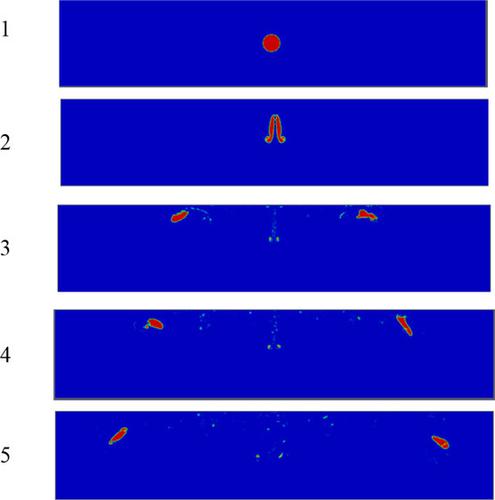当前位置:
X-MOL 学术
›
Propellants Explos. Pyrotech.
›
论文详情
Our official English website, www.x-mol.net, welcomes your feedback! (Note: you will need to create a separate account there.)
Simulation of the Air Bubble Temperature in the Firing Projectile
Propellants, Explosives, Pyrotechnics ( IF 1.8 ) Pub Date : 2021-03-23 , DOI: 10.1002/prep.202000225 Sina Bagheri 1 , Saeed Tavangar 1 , Hosein Soury 1 , Seyyed Hadi Motamed Shariati 1
Propellants, Explosives, Pyrotechnics ( IF 1.8 ) Pub Date : 2021-03-23 , DOI: 10.1002/prep.202000225 Sina Bagheri 1 , Saeed Tavangar 1 , Hosein Soury 1 , Seyyed Hadi Motamed Shariati 1
Affiliation

|
It is important to know the process of hot spot creation to improve the safety of working with melted TNT. One of the probabilities is the air bubbles in TNT that melted during the firing and internal ballistics, which are the results of casting problems. Thus, in this paper, the accuracy of this probability was studied. Melted TNT is a highly viscous fluid, so in this study by improving the numerical code, the effects of the temperature-dependent physical properties have been seen in the calculations. The results show that the viscosity work makes the bubble heated and rises, its temperature in comparison with the fluid environment. But the variations are a maximum of 4 °K. Therefore, it seems that the studied factors in this paper can′t be the reason for melted TNT undesirable ignition.
中文翻译:

发射弹丸中气泡温度的模拟
重要的是要了解热点创建过程,以提高使用熔化的 TNT 的安全性。一种可能性是 TNT 中的气泡在射击和内部弹道过程中熔化,这是铸造问题的结果。因此,在本文中,研究了该概率的准确性。熔化的 TNT 是一种高粘性流体,因此在本研究中通过改进数值代码,在计算中看到了温度相关物理特性的影响。结果表明,粘度功使气泡加热并上升,其温度与流体环境相比。但变化最大为 4 °K。因此,本文所研究的因素似乎不能成为熔化的TNT不希望着火的原因。
更新日期:2021-03-23
中文翻译:

发射弹丸中气泡温度的模拟
重要的是要了解热点创建过程,以提高使用熔化的 TNT 的安全性。一种可能性是 TNT 中的气泡在射击和内部弹道过程中熔化,这是铸造问题的结果。因此,在本文中,研究了该概率的准确性。熔化的 TNT 是一种高粘性流体,因此在本研究中通过改进数值代码,在计算中看到了温度相关物理特性的影响。结果表明,粘度功使气泡加热并上升,其温度与流体环境相比。但变化最大为 4 °K。因此,本文所研究的因素似乎不能成为熔化的TNT不希望着火的原因。


























 京公网安备 11010802027423号
京公网安备 11010802027423号